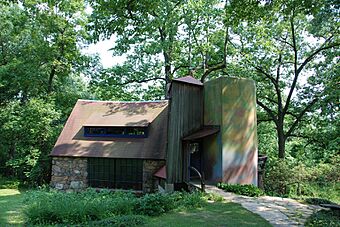Wharton Esherick Studio facts for kids
|
Wharton Esherick Studio
|
|

Wharton Esherick Studio
|
|
| Location | 1520 Horseshoe Trail, near Malvern, Tredyffrin Township, Pennsylvania |
|---|---|
| Area | 12 acres (4.9 ha) |
| Built | 1926-1966 |
| Architect | Wharton Esherick |
| Architectural style | Arts and Crafts, vernacular architecture, expressionism, modernism |
| NRHP reference No. | 73001615 |
Quick facts for kids Significant dates |
|
| Added to NRHP | April 26, 1973 |
| Designated NHL | April 19, 1993 |
The Wharton Esherick Studio is a special place that was both the home and workshop of a famous artist named Wharton Esherick (1887-1970). He was known for making amazing sculptures and unique wooden furniture. He built this studio himself over many years, from 1926 to 1966. It's located on Valley Forge Mountain in Malvern, Pennsylvania. The studio shows off Esherick's interest in different art styles, like Arts and Crafts and Modernist art. Today, it's a museum called the Wharton Esherick Museum, where people can visit and see his incredible work.
Contents
Discovering the Wharton Esherick Studio
The Wharton Esherick Studio is more than just a building. It's a work of art all by itself! Wharton Esherick designed and built almost everything in it. This includes the walls, the door handles, and even the light pulls. He wanted the entire place to be a single, complete artwork. This idea is sometimes called a Gesamtkunstwerk, which is a German word meaning "total work of art."
A Home Built by an Artist
Wharton Esherick spent 40 years building and changing his studio. He started in 1926 and kept working on it until 1966. This long project shows how dedicated he was to his art. The studio is built into the side of Valley Forge Mountain. It reflects many different art and design styles that were popular in the 1900s. These styles include Arts and Crafts, German Expressionism, and Modernist sculpture.
What You Can See at the Museum
The Wharton Esherick Museum has four main buildings on its site. The most important is the Wharton Esherick Studio itself. This is where Esherick lived and created his art. There's also a workshop built in 1956. Esherick designed this workshop with help from famous architects Louis Kahn and Anne Tyng.
Another interesting building is the old log garage from 1928. It was built in the German Expressionist style. Today, this garage is used as the museum's visitor center. You can also see Esherick's woodshed. There's even a newer version of his old outhouse from the 1920s.
Inside the studio, you'll find more than 300 of Wharton Esherick's artworks. These include his sculptures, furniture, paintings, and prints. It's like stepping into the mind of an artist!
The Studio as a National Treasure
The Wharton Esherick Museum became a non-profit organization in 1971. It opened its doors to visitors in 1972. Just a year later, in 1973, it was added to the National Register of Historic Places. This list includes important historical sites across the United States. In 1993, the studio was given an even higher honor. It was declared a National Historic Landmark. This means it's considered one of the most important historic places in the entire country.



